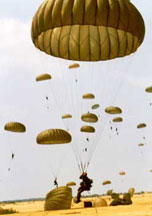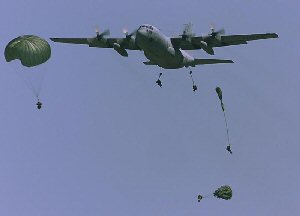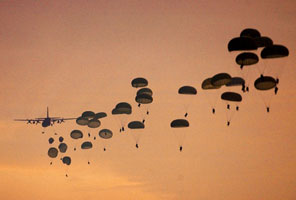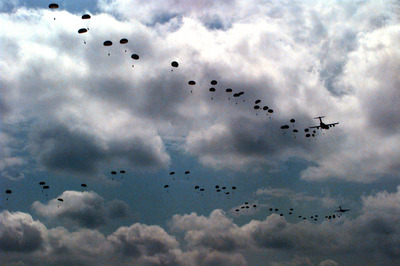The Basic Airborne Course, Ft. Benning, Georgia
At Army Jump School, you will learn how to jump out of an aircraft, navigate by using your parachute, land safely on the ground and move on to a combat objective. Fort Benning, Georgia is where Army paratroopers are trained and the coveted airborne wings are earned. The three-week school is usually accomplished after a soldier completes Basic Combat Training (BCT) and Advanced Individual Training (AIT). All graduates of Ranger School and the Special Forces Qualification Course also attend Airborne School during their training pipelines. The 1st Battalion (Airborne), 507th Infantry Regiment is responsible for running the U.S. Army Airborne School. The Airborne instructors are also known as the “Black Hats” and are from the U.S. Army, Marine Corps, Navy and Air Force. Students are trained in the use of static line deployed T-10C parachutes.
Attending Airborne School requires passing the selection process. To qualify, a soldier must pass the Army Physical Fitness Test (APFT), earning a minimum score of 60 points per event (push ups, sit ups, and 2 mile run) based on the 17-21 year old APFT standards. The maximum age for attending the Airborne School is 36 years of age.
Airborne School is broken into three one-week phases: Ground Week, Tower Week, and Jump Week. At Airborne school, soldiers will train along side Regular Army officers and enlisted men and women, as well as members of the other armed services, and jump from Air Force aircraft including the C-130 Hercules and C-17 Globemaster.
Week 1 – Ground Week
Before you get to jump out of a plane you must first learn how to land on the ground safely. The T-10C round-shaped parachute that static-line paratroopers jump with drops you with plenty of downward force – you must learn the skills required to safely transition to landing and absorb the downward force preventing injury. Soldiers are taught how to wear the parachute harness correctly and how to use the special training gear. During Ground Week, soldiers will spend a lot of time learning, practicing, and perfecting their Parachute Landing Fall (PLF). This maneuver teaches a soldier to transfer the energy of your fall (landing) up the sides of the lower legs and knees, all the way up to side of the upper body. The key is landing with your feet and knees together.
To practice the PLFs, soldiers will jump from platforms of various heights into sand or pebble pits simulating the final stage of parachute landing. All the while, the Black Hat instructors observe and correct the soldier’s body position and PLF technique. Over and over a soldier will practice the PLF – expect a soldier’s body to become quite sore from the repetitive falling as well as the uniform to get beat up. This week culminates in practice jumps from a 34-foot tall tower to practice landings. The 34-foot tower introduces a soldier to the sensation of actually falling from height – a feeling similar to an actual jump.
To continue to week 2, you must pass all jump training test as well as the physical fitness requirements. Some students that are unable to advance may require additional training or get “recycled” to another class due to lack of progress or injury.
Week 2 – Tower Week
The second week of Jump School concentrates on the jump towers. Soldiers will continue using the 34-foot tower and will also use the swing-landing trainer, the suspended harness, and the 250-foot tower. Soldiers will become familiar with the mock door trainer to simulate mass exit training (how to exit an aircraft in flight). Parachute jumps from the 250-foot high tower culminate the second week of training and are the final transition from ground training to actual parachuting.
Additionally, soldiers are taught the different phases of parachute flight from aircraft exit, through opening shock and chute deployment, then onto the deployment of the risers, steering the chute, and all the way to landing. One critical skill learned is how to identify a parachute malfunction and deal with it. This may involve emergency procedures including when and how to deploy the reserve parachute. Soldiers also learn about oscillation, landing falls, and how to recover from drag. The T-10C parachute is partially steerable using the parachute risers and soldiers are taught the different techniques to steer their chutes into the wind and aim for the Point of Impact at the center of the Drop Zone. The second week completes a soldier’s individual skill training and begins building team effort skills.
Once successfully completing the skills required and the physical fitness requirements, a soldier progresses to jump week.
Week 3 – Jump Week
 Finally, soldiers get to practice their new skills while jumping out of real aircraft in flight. The C-130 or C-17 aircraft pick up the paratrooper students right in front of the hangar at Lawson Army Airfield, from there it is a very short flight to Friar Drop Zone where all of the training jumps are accomplished. The Air Force aircraft fly at 1200 feet above the ground at an airspeed of about 130 MPH. After the flight crew completes the pre-drop and slow-down checklists, soldiers rise out of their seats and move at the jumpmaster’s direction to one of two paratroop doors (on each side of the aircraft). At “green light” one stick of soldiers exits the plane – jumpers continue to move to the door until the red light is illuminated. At that point the aircraft will begin its racetrack maneuver circling back to the beginning of the drop zone and continue to do this until all jumpers have jumped.
Finally, soldiers get to practice their new skills while jumping out of real aircraft in flight. The C-130 or C-17 aircraft pick up the paratrooper students right in front of the hangar at Lawson Army Airfield, from there it is a very short flight to Friar Drop Zone where all of the training jumps are accomplished. The Air Force aircraft fly at 1200 feet above the ground at an airspeed of about 130 MPH. After the flight crew completes the pre-drop and slow-down checklists, soldiers rise out of their seats and move at the jumpmaster’s direction to one of two paratroop doors (on each side of the aircraft). At “green light” one stick of soldiers exits the plane – jumpers continue to move to the door until the red light is illuminated. At that point the aircraft will begin its racetrack maneuver circling back to the beginning of the drop zone and continue to do this until all jumpers have jumped.
A soldier must complete 5 jumps, including one night jump in order to graduate Airborne School. During jump week, the schedule varies and soldiers will jump in a variety of configurations from no load (Hollywood style) all the way to a full combat load jump. Jump week can be chaotic as the mass of soldiers stand in the ready-room waiting to be loaded onto the aircraft one chalk at a time. Once landing on the drop zone, soldiers gather their chutes and gear and meet back at the rally point (on the side of the DZ) and wait for a bus ride back to Lawson AAF to get ready for their next jump.
Graduation is normally conducted at 0900 on Friday of Jump Week at the south end of Eubanks Field on the Airborne Walk. However, if there is inclement weather, or other factors delay the scheduled jumps, graduation may be conducted on Fryar Drop Zone (DZ) following the last jump. Guests and family members are welcome to observe all of the jumps at the DZ, attend the graduation ceremony, and participate in awarding the parachutist wings to the soldiers. The jump schedule varies greatly based on class dynamics, weather, and aircraft. On graduation day, families should not expect to spend much time with their soldiers. Often, families will only spend a few minutes with their soldier, pinning on his or her new airborne wings… then the soldier may be immediately departing to attend another advanced Army school or to report to another duty station. Book your hotels early as the hotels in town get booked up quick for graduation week. Check out the cheapest rates on hotels in Fort Benning, GA.
Fryar DZ is located on the Fort Benning Military Reservation. To get to Fryar Field DZ, visitors should drive to Lawson Army Airfield (LAAF). Drive to the left around LAAF. At the stop sign turn left and drive about 5 miles to the next stop sign. Follow signs to the drop zone parking area. Following graduation you are allowed to depart for leave, or your next duty assignment.
Throughout the fast-moving course of instruction, mental alertness and physical conditioning are emphasized. Physical conditioning is a must prior to attending this course. Airborne School is designed for those who possess the desire, motivation and courage to join the elite fraternity known as “THE AIRBORNE.”

 WARNING: WHEN CONDUCTING PHYSICAL TRAINING PRIOR TO THE BASIC AIRBORNE COURSE AT YOUR HOME STATION, DESIGN A PROGRAM TO ACHIEVE THE FOLLOWING: COMPLETION OF A 5 MILE RUN WITH A TIME OF 45 MINUTES OR FASTER AFTER CONDUCTING 30 MINUTES OF STRENUOUS ACTIVITY (MUSCULAR STRENGTH EXERCISES, MUSCULAR ENDURANCE EXERCISES, CALISTHENICS, AND GRASS DRILLS).
WARNING: WHEN CONDUCTING PHYSICAL TRAINING PRIOR TO THE BASIC AIRBORNE COURSE AT YOUR HOME STATION, DESIGN A PROGRAM TO ACHIEVE THE FOLLOWING: COMPLETION OF A 5 MILE RUN WITH A TIME OF 45 MINUTES OR FASTER AFTER CONDUCTING 30 MINUTES OF STRENUOUS ACTIVITY (MUSCULAR STRENGTH EXERCISES, MUSCULAR ENDURANCE EXERCISES, CALISTHENICS, AND GRASS DRILLS).
You must be physically fit before you start the Basic Airborne Course. The physically weak are more likely to either not complete the course because of an injury, or fail the course due to an inability to qualify on the training apparatuses. You will have PT the first period each day, followed by seven hours of demanding, rigorous training.
You must qualify during daily PT by completing the exercises and distance run. Any student who fails to complete two runs during the entire course will be eliminated from training. A typical daily PT session includes warm up exercises, calisthenics, guerilla/grass drills or a 3.2 to 4 mile formation run. Males and females run in the same formation during PT and the average pace is 9-minutes per mile. Train now and get fit – check out the Army Special Forces Workout to prepare you for Airborne School.
Deploying soon? Check out our Afghanistan Gear List and prepare for your deployment in support of Operation ENDURING FREEDOM. Also check out out 160th Special Operations Aviation Regiment page.
Looking for historical information such as old class photos or rosters of your graduating class? Have questions about your Airborne School class or want access to past records? Try our comprehensive military records search resource.
Need to contact the Airborne School Directly? Call the points of contact below.
Administrative Information
During Airborne School, soldiers will have nights and weekends off. Soldiers can keep a mobile phone in their possession, but calls can only be made after duty hours. Soldiers in the Airborne School can also have visitors during nights and weekends, schedule permitting. During non-duty hours, soldiers are normally free to travel within a 50-mile radius of Fort Benning without a valid leave form. All soldiers must return well rested and on time for company-designated formations the following morning.
Airborne School Contact Information
Here is the latest contact information for the Ft. Benning Basic Airborne Course Schoolhouse. For Student Class Information and questions such as “how can I get in touch with an Airborne student?” or “when is Airborne School class graduation?”, please call this number: 706-545-4874.
| U. S. Army Airborne School Student Accountability NCOIC | 706-545-4874 |
| FAX | 706-545-3243 |
| U. S. Army Jumpmaster School NCOIC
HHC 1/507th |
706-545-3885 706-545-5412 |
| FAX | 706-545-4923 |
| U. S. Army Pathfinder School NCOIC
HHC 1/507th |
706-545-3218 706-545-1111 |
| FAX | 706-545-2781 |
| BN S-3 | 706-545-6495 |
| BN S-3 NCOIC | 706-545-6262 706-545-1074 |
| BN S-4 | 706-545-6490 |
| POI Manager/Technical Writer | 706-545-3458 |
| Chaplain | 706-545-3715 |
| Post Locator | 706-545-5217 |
| Student and Class Information | 706-545-4874 706-545-9931 706-545- 9996 |
Information transcribed from the 1-507th official website and actual contact information not independently verified.
Operation Large Package
82nd Airborne – Green Ramp, Fort Bragg NC Large Package is an exercise held at Pope Field and the Fort Bragg Reservation. It is a bilateral exercise with Air Force C-130 Hercules and C-17 Globemaster aircraft and aircrews flying while Army Airborne paratroopers jump from the planes. Four thousand 82nd Airborne Division paratroopers take part in an aerial assault exercise called Large Package Week culminating in a brigade-sized airdrop. The quarterly training exercise sharpens the airdrop capability of aircrews from the Air Mobility Command and the 82nd Airborne. The exercise is labeled “Large Package” due to the size of the airborne element being dropped.
The sheer number of paratroopers jumping into the drop zone requires a large formation of Air Force aircraft – often as many as 18 C-130 aircraft will fly in formation, navigating to the drop zone at night at 800 feet above the ground and opening their paratroop doors for the jumpers to exit. The aircraft airdrop paratroopers and heavy equipment and the event culminates in a large-scale brigade ground exercise.
Once airdropped out of the aircraft, the paratroopers will rally at predetermined points on the drop zone, assemble their units for offensive operations and retrieve their heavy equipment that was airdropped nearby – including large artillery pieces and vehicles. The ground force will maneuver across the drop zone and practice their practice airfield seizure tactics.


Large Package Week – Airfield Seizure
 A U.S. Air Force C-130 Hercules passed overhead and green parachutes dotted the evening sky above nearby Fort Bragg on May 11. Eight seconds later, the first Soldiers from the Army’s 18th Airborne Corps charged across the ground launching a simulated airfield assault.
A U.S. Air Force C-130 Hercules passed overhead and green parachutes dotted the evening sky above nearby Fort Bragg on May 11. Eight seconds later, the first Soldiers from the Army’s 18th Airborne Corps charged across the ground launching a simulated airfield assault.
The Large Package Week exercises showed the vital role bluesuiters play in joint operations to help Soldiers bring the fight to the enemy, officials said.
Aircraft involved in the week’s exercises were four C-130 Hercules from here, and six from Little Rock Air Force Base, Ark., as well as two C-17 Globemaster IIIs from Charleston AFB, S.C., and McChord AFB, Wash. Together they dropped equipment and about 800 paratroopers, said Master Sgt. Brian Harriman, the exercise’s production supervisor from the 743rd Aircraft Maintenance Squadron here.
Airmen and Soldiers train together during the exercises which are designed to help prepare the 82nd Airborne Division’s incoming Ready Division. Sergeant Harriman said the Ready Division Soldiers are typically on alert for six weeks and must be capable of deploying anywhere to conduct combat operations within 18 hours.
The majority of training occurs at night because that is when Soldiers typically go into battle, said Maj. Chul Lee, command post chief.
“Night operations lessen the threat (of) exposure and also increase the element of surprise against enemy targets,” he said.
Airmen are vital to the 82nd’s capabilities to perform its mission, Sergeant Harriman said.
“The Air Force role is critical when a crisis breaks because (the airlifters get) the 82nd Airborne Division where it needs to go,” he said.
Along with actual airlift missions, Airmen must also manage and maintain all participating aircraft. Roughly 90 maintainers from the 743rd AMXS take part in the training, and they prepare the “packages,” which include equipment like military vehicles.
Sergeant Harriman said he recognizes and emphasizes the importance of joint operations for accomplishing America’s national objectives.
“The key to success is two services operating as one unit to get the job done,” he said.
82d Airborne Division – The All Americans
 Fort Bragg is known as the “Home of the Airborne and Special Operations Forces”. Fort Bragg houses the 82nd Airborne Division and the XVIII Airborne Corps. The U.S. Army Special Operations Command and the U.S. Army Parachute Team (the Golden Knights) also call Fort Bragg home.
Fort Bragg is known as the “Home of the Airborne and Special Operations Forces”. Fort Bragg houses the 82nd Airborne Division and the XVIII Airborne Corps. The U.S. Army Special Operations Command and the U.S. Army Parachute Team (the Golden Knights) also call Fort Bragg home.
The 82nd Division is known as a Ready Division with an alert commitment. The 82nd maintains a Parachute Battalion Combat Team (BCT) as the initial ready force. It can depart Fort Bragg in 18 hours or less….the initial company can be gone in 8 hours if required for a contingency.
From their inception to their patch, these units have a legendary history. The “AA” on the 82 Airborne Division patch stands for “All American”. The XVIII Airborne Corps is known as the Sky Dragons.
Fort Bragg units include the 1st Corps Support Command, 44th Medical Command, XVIII Airborne Corps Artillery, 18th Aviation Brigade, 35th Signal Brigade, and more.
Soldiers of the U.S. Army’s 82nd Airborne Division stream out from two U.S. Air Force C-17 Globemasters III over the Sicily drop zone at Fort Bragg, N.C. The soldiers are rehearsing to take part in the longest distance airborne operation in history during Exercise Central Asian Battalion. Exercise Central Asian Battalion involves more than 900 military personnel from Georgia, Kazakhstan, Kyrgyzstan, Latvia, Russia, Ukraine and Uzbekistan who are training with over 500 U.S. military troops to hone their skills in peacekeeping and humanitarian assistance. The exercise will enhance regional cooperation and increase interoperability training among NATO and Partnership for Peace nations. The exercise is being held in Shymkent, Kazakhstan, and Chirchik, Uzbekistan.

Ranger Combat Gear
Lone Survivor
 Four US Navy SEALS departed one clear night in early July, 2005 for the mountainous Afghanistan-Pakistan border for a reconnaissance mission. Their task was to document the activity of an al Qaeda leader rumored to have a small army in a Taliban stronghold. Five days later, only one of those Navy SEALS made it out alive.
Four US Navy SEALS departed one clear night in early July, 2005 for the mountainous Afghanistan-Pakistan border for a reconnaissance mission. Their task was to document the activity of an al Qaeda leader rumored to have a small army in a Taliban stronghold. Five days later, only one of those Navy SEALS made it out alive.
This is the story of the only survivor of Operation Redwing, US Navy SEAL Petty Officer Marcus Luttrell, and the extraordinary firefight that led to the largest loss of life in American Navy SEAL history. Lt. Michael P. Murphy led the team of PO2 Luttrell, PO2 Dietz and PO2 Axelso. Luttrell fought valiantly beside his teammates until he was the only one left alive, blasted by an RPG into a place where his pursuers could not find him. Over the next four days, terribly injured and presumed dead, Luttrell crawled for miles through the mountains and was taken in by sympathetic villagers who risked their lives to keep him safe from surrounding Taliban insurgents.
Masters of Chaos
 The wars in Afghanistan and Iraq have given the U.S. Army’s Special Forces, also known as the Green Berets, a central role in American military action like never before. Several hundred U.S. Special Forces operators helped a motley band of Afghan rebels orchestrate a stunning rout when they overthrew the Taliban after 9/11. In Iraq, as journalist Linda Robinson explains in Masters of Chaos: The Secret History of the Special Forces, Special Forces units were the main U.S. elements on the ground in the northern and western regions of the country, where they defeated government forces that outnumbered them many times over. Robinson tells the story of the Special Forces through the eyes of a few of its more colorful personalities, men with call signs like Rawhide and Killer. She follows them around the world from Panama and El Salvador to Somalia, Kosovo, and, finally, Afghanistan and Iraq. Surprisingly, however, she devotes only a few pages to the Green Beret-led victory in Afghanistan, even though it was arguably their greatest achievement since they were created after World War II.
The wars in Afghanistan and Iraq have given the U.S. Army’s Special Forces, also known as the Green Berets, a central role in American military action like never before. Several hundred U.S. Special Forces operators helped a motley band of Afghan rebels orchestrate a stunning rout when they overthrew the Taliban after 9/11. In Iraq, as journalist Linda Robinson explains in Masters of Chaos: The Secret History of the Special Forces, Special Forces units were the main U.S. elements on the ground in the northern and western regions of the country, where they defeated government forces that outnumbered them many times over. Robinson tells the story of the Special Forces through the eyes of a few of its more colorful personalities, men with call signs like Rawhide and Killer. She follows them around the world from Panama and El Salvador to Somalia, Kosovo, and, finally, Afghanistan and Iraq. Surprisingly, however, she devotes only a few pages to the Green Beret-led victory in Afghanistan, even though it was arguably their greatest achievement since they were created after World War II.
Special Operations in Iraq
 This sensational book reveals the true and compelling story of the Special Force units of the Coalition, such as the SAS, SBS and Delta Force who worked in the shadows, often unseen, unheard and unsung. It describes their missions behind the lines from the early days, well before hostilities opened formally. It was an open secret that groups were deployed probably operating in the western desert against Saddam’s forces and the Scud missile threat. What was actually going on is revealed here and until now their roles and actions have not been described in any detail. These are thrilling tales of incredible daring and endurance told by men whose courage and military skills are inspiring. The book also covers operations such as the spectacular rescue of POW Private Lynch and the secret operations to target Saddam and other leaders of his regime of terror.
This sensational book reveals the true and compelling story of the Special Force units of the Coalition, such as the SAS, SBS and Delta Force who worked in the shadows, often unseen, unheard and unsung. It describes their missions behind the lines from the early days, well before hostilities opened formally. It was an open secret that groups were deployed probably operating in the western desert against Saddam’s forces and the Scud missile threat. What was actually going on is revealed here and until now their roles and actions have not been described in any detail. These are thrilling tales of incredible daring and endurance told by men whose courage and military skills are inspiring. The book also covers operations such as the spectacular rescue of POW Private Lynch and the secret operations to target Saddam and other leaders of his regime of terror.
Among Warriors in Iraq
 Join Big Hungry, Kentucky Rife, Serpico and Jedi Knight for a harrowing journey into the heart of the Iraqi insurgency. A former Marine infantryman, Tucker follows the warriors of the 101st Airborne Division in Mosul and the 82nd Airborne and 10th Mountain Divisions in Fallujah during 19 weeks of urban warfare in late 2003 and early 2004. In declaratives one might describe as debased Hemingway on speed, Tucker tags along for counter-IED (improvised explosive devices) patrols and zero-dark-30 (predawn) raids, capturing the adrenaline-laced urgency of urban combat against a hidden enemy. His conversations with troopers are refreshingly authentic; his analysis of the politics of Iraq tends toward open advocacy for the Kurds and a separate state of Kurdistan. (Tucker is the author of Hell Is Over: Voices of the Kurds After Saddam.) But his gritty firsthand account is packed with detail: from the slow ballet of “scoping roof tops and alley corners,” the excruciating tension of disarming IEDs and the frenetic choreography of urban combat to the children who are never far away and are always quick with a smile, a wave and an enthusiastic “Amerikee!” Several impressive accounts of the second Iraq War have appeared already from embedded journalists, but few are as personal and edgy as Tucker’s.
Join Big Hungry, Kentucky Rife, Serpico and Jedi Knight for a harrowing journey into the heart of the Iraqi insurgency. A former Marine infantryman, Tucker follows the warriors of the 101st Airborne Division in Mosul and the 82nd Airborne and 10th Mountain Divisions in Fallujah during 19 weeks of urban warfare in late 2003 and early 2004. In declaratives one might describe as debased Hemingway on speed, Tucker tags along for counter-IED (improvised explosive devices) patrols and zero-dark-30 (predawn) raids, capturing the adrenaline-laced urgency of urban combat against a hidden enemy. His conversations with troopers are refreshingly authentic; his analysis of the politics of Iraq tends toward open advocacy for the Kurds and a separate state of Kurdistan. (Tucker is the author of Hell Is Over: Voices of the Kurds After Saddam.) But his gritty firsthand account is packed with detail: from the slow ballet of “scoping roof tops and alley corners,” the excruciating tension of disarming IEDs and the frenetic choreography of urban combat to the children who are never far away and are always quick with a smile, a wave and an enthusiastic “Amerikee!” Several impressive accounts of the second Iraq War have appeared already from embedded journalists, but few are as personal and edgy as Tucker’s.
Special Forces Training is demanding. Prepare yourself for your training, mentally and physically. Set yourself up for success – excel at your new Special Ops military career!




















